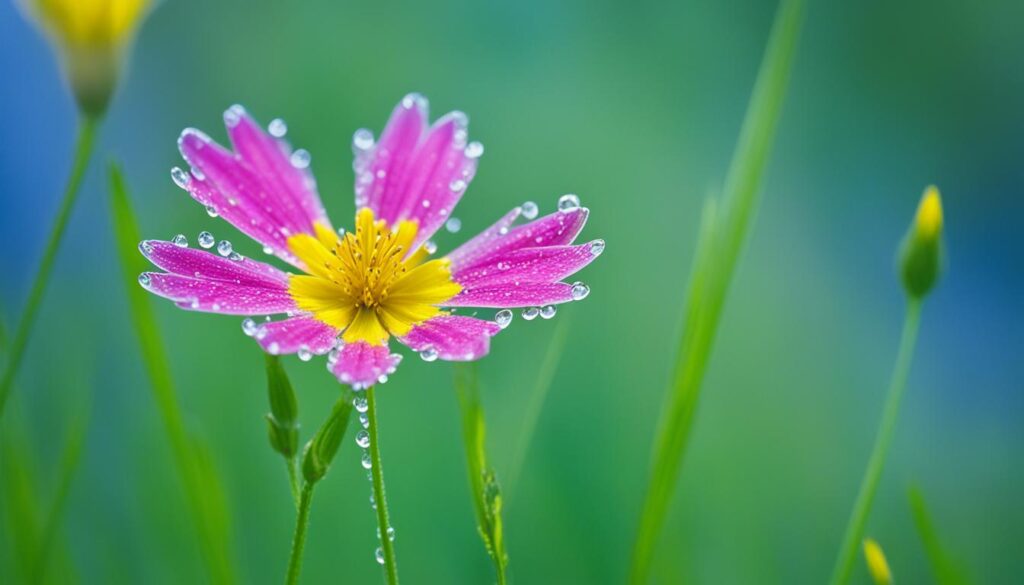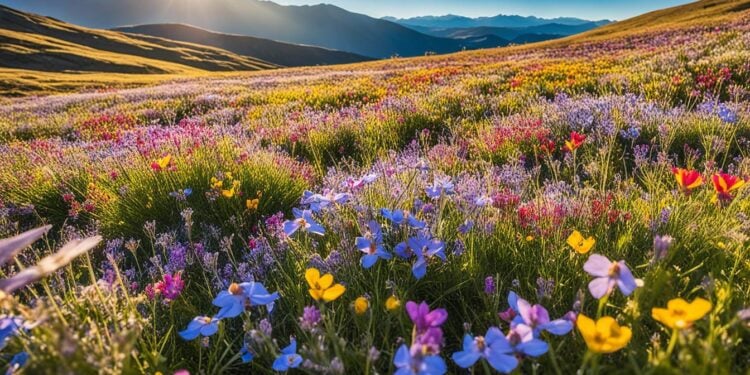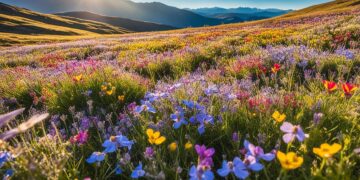As the sun warms the earth, a colorful landscape unfolds. Spring brings wildflowers out of their winter sleep, showing us their beauty. These flowers, with their delicate and bold colors, show us nature’s beauty.
If you love hiking, nature, or just enjoying the outdoors, spring wildflowers will touch your heart. They make us pause, enjoy the moment, and admire nature’s art.
Across the U.S., spring wildflowers are found everywhere, each one special in its own way. Let’s explore these beautiful flowers, find the best places to see them, and learn how to capture their beauty with a camera.
Nature’s Vibrant Awakening
As winter ends, spring wildflowers start to bloom, marking the start of a new season. These plants are the first signs of spring, showing off a world of colors. The blooming season is a time of renewal, offering a feast for our senses with its variety of wildflowers.
Wildflowers: The Harbingers of Spring
Spring wildflowers signal the change in seasons. They grow through the soil, opening their petals to show off beautiful colors. From soft pastels to bold colors, the landscape turns into a stunning work of art. These flowers welcome warmer weather and new life.
Nature’s Palette: A Kaleidoscope of Colors
The spring wildflower season celebrates nature’s diversity. The landscape is filled with colors, each species adding its own shade. From soft pinks and whites to bright yellows, purples, and oranges, the colors are amazing. This colorful display invites us to enjoy the beauty of nature and the spring blooming season.
Wildflower Hotspots: Where to Find Nature’s Gems
Across the United States, many places let you dive into the beauty of spring wildflowers. You can find them from the coast to the mountains, in national parks and local nature spots. These spots are perfect for seeing nature’s hidden treasures. They let you see the vibrant colors of spring flowers up close.
The Great Smoky Mountains National Park is a top spot for wildflower lovers. It has a wide variety of spring flowers, like delicate trilliums and vibrant rhododendrons. You can find these flowers along the park’s trails, hidden in beautiful spots.
If you like the coast, the Pacific Northwest has amazing wildflowers too. Places like Olympic National Park and Mount Rainier National Park show off beautiful flowers. You’ll see things like the glacier lily and the Pacific lupine.
Love the high peaks or the rolling hills? There are many wildflower spots to check out. From Glacier National Park’s bright meadows to Indiana Dunes National Park’s hidden paths, these places show off spring’s wildflower beauty.
The Ephemeral Beauty of Spring Wildflowers
Spring brings new life, filling the world with vibrant wildflowers. These flowers bloom briefly, lasting only a few weeks. Their short lives make us appreciate the beauty of the moment.
The life of wildflowers is linked to nature’s cycles. As days get longer and warmer, they wake up from sleep. Their colors burst out, painting the landscape. But soon, they fade away, saving energy for summer.
Appreciating the Fleeting Moments
Spring wildflowers teach us to be present and respectful. By paying attention, we can enjoy the beauty of the season. We can watch the flowers and the bees, feeling close to nature.
In our fast-paced world, wildflowers remind us to slow down. They show us the beauty of the present. By being mindful, we keep their memory alive, deepening our bond with nature.
Wildflower Photography: Capturing Nature’s Artistry
Spring wildflowers are a feast for the eyes, with their bright colors and gentle shapes. They’re perfect for nature photographers who want to capture beauty. Learn how to keep nature’s art alive through your camera.
Tips for Stunning Wildflower Shots
To get great wildflower photos, know your camera settings and try new ways to compose your shots. Play with aperture to focus on the flowers and blur the background. Adjust your shutter speed to freeze or blur the petals for movement.
How you arrange your shot is also important. Get low to show the flower’s details from a new view. Use the rule of thirds to make your photo more interesting. Try different angles to find the best shot.
Lighting is key for wildflower photos. Look for soft, diffused light on cloudy days or during the golden hour. This light makes colors pop and adds a natural glow. Stay away from the harsh light of midday to avoid shadows and dull colors.
Patience and detail are crucial in capturing wildflowers. Take your time to explore and respect the flowers and their home. With practice and an eye for beauty, you’ll capture the essence of spring wildflowers.

Wildflower Identification: Unraveling Nature’s Diversity
Exploring spring wildflowers is an exciting adventure. These plants come in many shapes, sizes, and colors. Each one has its own special story. As you learn to identify them, you’ll be amazed by the details that make each species unique.
Spring wildflowers range from delicate to bold and colorful. Their variety shows nature’s beauty. By learning to spot these plants, you’ll grow to love nature more. It’s great for anyone who loves exploring the outdoors or just enjoys its beauty.
Start by diving into the world of native wildflowers. Look closely at their shapes, colors, and textures. Use guides and journals to learn what makes each one special. With each new discovery, you’ll understand nature better and respect its balance.
Start your wildflower identification journey and be amazed by spring’s beauty. Dive into their colors, shapes, and stories. Discover the secrets of these beautiful plants and the world they live in.
The Ecological Importance of Wildflowers
Wildflower ecosystems are key to keeping our natural world in balance. They are more than just pretty flowers. They are a main food source and home for many pollinators like bees, butterflies, and hummingbirds. This relationship between wildflowers and pollinators is vital for the health and variety of our environment.
Pollinators and Wildflowers: A Symbiotic Relationship
Pollinators, including insects and birds, need the nectar and pollen from wildflowers to survive. In return, they help spread wildflower seeds, keeping these ecosystems growing and diverse. Supporting pollinators helps keep our natural world healthy and protects the important role wildflowers play in our ecosystem.
Wildflower ecosystems do more than just look good. They help control the climate, clean the air and water, and stop soil from washing away. It’s important to save and protect these areas to fight climate change and keep our planet healthy.

As we make our cities bigger, wildflowers in urban areas become even more crucial. These tough plants can live in small green spaces, giving pollinators a place to find food and helping our cities be more diverse. Adding wildflowers to our city plans makes our communities more sustainable and eco-friendly.
Nature’s Resilience: Wildflowers in Urban Settings
In the heart of our cities, a surprising sight can be found – urban wildflowers. These plants can grow in unexpected places, like sidewalk cracks and city gardens. They show how nature can thrive even in tough spots, proving its strength and flexibility.
Urban wildflowers are taking back their spot in our cities. They remind us how even small green spaces can greatly impact our environment. These flowers are key in bringing back natural habitats and helping our cities adapt to nature.
As we work to make our cities better, urban wildflowers remind us why green spaces are crucial. They make our cities look beautiful and support important ecosystems. These flowers give food and shelter to pollinators and other wildlife.
By celebrating urban wildflowers, we learn to value nature’s ability to adapt and survive in tough places. This inspires us to design our cities better, making sure nature and wildlife have a place among our buildings and roads.
Wildflower Gardening: Bringing Nature Home
Embrace the beauty of spring wildflowers by creating a lush, natural haven in your backyard. Wildflower gardening lets you make a vibrant oasis that draws in pollinators and celebrates the season’s colors. Growing native wildflowers turns your outdoor space into a thriving ecosystem that shows off nature’s beauty.
Creating a Wildflower Haven in Your Backyard
Designing a pollinator-friendly landscape with native wildflowers is rewarding. It brings the beauty of spring to your backyard. Choose different species that bloom at various times for a continuous display of colors. From delicate trillium to bold Indian paintbrush, these plants will make your space a haven for butterflies, bees, and other creatures.
To start your wildflower haven, research native plants for your area and pick a sunny, well-drained spot. Use a mix of annuals, perennials, and self-seeding plants for a lush, changing garden. This approach provides nectar-rich blooms for pollinators and supports the local ecosystem.







